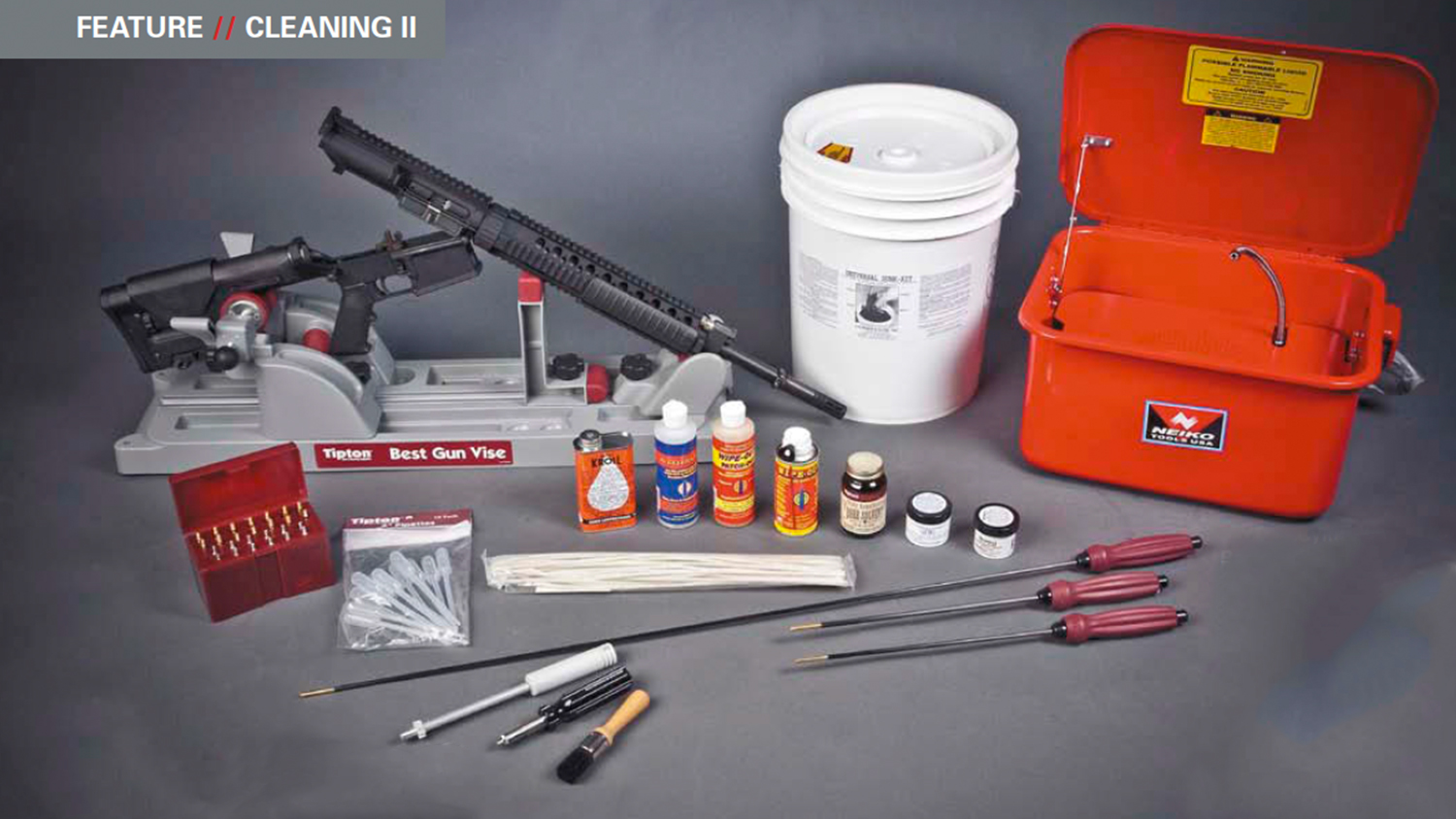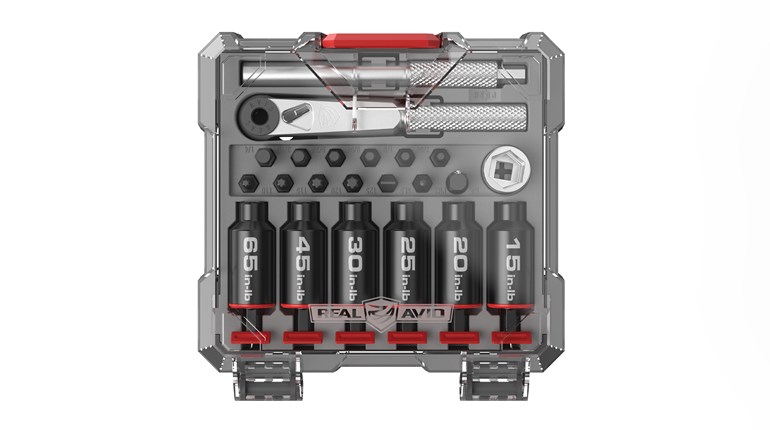
This article follows Part I on match barrel cleaning. Like panning for gold, we sifted through the “mud and sand” of folklore and wives tales on high power gun cleaning before finding the “nuggets” for this article.
Despite the number of new cleaning products on the market, some will lament: “I still like the smell of brand X.” Improvements in industrial lubricants and cleaners for the marine, aviation and auto industries have benefited shooting sports in general, and competitive shooting specifically. As Frank Ventimiglia of Shooter’s Choice put it, “In the ‘50s and ‘60s we painted cars and motorcycles with fragile lacquer paint that was full of harmful, volatile organic compounds (VOCs). Today, we use water-based paint that does a better job.” Similarly, many of the new gun-cleaning products are water-based and they do a better job than the old favorites, without the risk of etching the metal with ammonia salts or chlorine.
How is Cleaning Different for Competitive Shooting?
Do no harm. Frequent practice sessions and tournaments will run thousands of rounds through a match gun before the barrel is retired. The higher precision expected of a match gun may move that retirement date up even sooner. By comparison, my sporterized ’03 Springfield has had fewer than 200 rounds shot through it in nearly 50 years of casual sighting-in and hunting. The cleaning objectives for that gun are simply to prevent rust and to ensure reliability—and to enjoy the aroma of brand X, of course. The care and feeding of my match guns is far more meticulous in order to preserve extreme accuracy and ensure reliability. Given the high ratio of cleaning strokes to bullets fired through match guns, the risk of damage during all that cleaning warrants careful attention. As stated in the medical profession’s Hippocratic Oath, we should attempt to “do no harm” during repetitive cleaning sessions.
Prevention versus cure. For competition barrels, prevention means conditioning the bore and throat to slow fouling. Whether the barrel was hand lapped at the time of manufacture or you treat it with an oil-based lubricant, moly (molybdenum) or PTFE (Teflon) solution, bullet velocity will increase, precision will improve and the rate of fouling will diminish with a conditioned barrel. This last benefit results in less frequent cleaning, reduced wear and prolonged accuracy during a match.
Cleaning Wisdom from the Pros
The Muzzle. Muzzle guards can prevent damage to the crown when using a cleaning rod on lever action and older military rifles and most revolvers that can only be cleaned from the muzzle. Why is this critical? Imagine 56,000-plus PSI of pressurized gas escaping from the muzzle as a halo surrounding the fired bullet. Unless the circumference of the crown is perfectly round, more gas will escape from worn areas, creating uneven pressure that will disrupt the flight of the bullet, however slightly. This is why either an 11-degree or stepped crown is popular among precision shooters because of the protection afforded from the recessed crown. Bore snakes or pull thrus can also be used to avoid running a cleaning rod across the muzzle. Care must be taken to keep bore snakes clean after repeated use.
The Throat. Because pressure and heat are highest at the throat, any carbon buildup in this area soon takes on the consistency of a tough, ceramic scale that is difficult to remove. As David Sams pointed out in Cleaning Part I, the ceramic-like carbon buildup can be avoided by pulling a “wet patch” (wetted with bore solvent) through the barrel before leaving the firing line.
Bore and Action. Older mechanical brush-cleaning methods have been improved through the use of modern solvents. By allowing ammonia-free solvent to sit in the chamber and bore for longer periods, carbon, copper and lead are emulsified to the point that they can be removed with fewer strokes of a hard bronze brush. Hours of mopping-up cleaning residue with Q-tips, rags and patches have been replaced by pressurized solvents such as Tetra’s Action Blaster, KG’s Solvent Degreaser or Shooter’s Choice’s Aqua Clean spray. Because of their astringent quality, these solvents also remove protective oil. Re-apply your preferred preservative within a few minutes of stripping the metal with cleaning solvents to avoid a fast-forming haze of surface rust.
Another criteria for selecting gun cleaners is how long it takes the product to work effectively. As in the car wax industry, some gun cleaning companies try to attract customers by advertising quick results. These products may use aggressive ammonia salts or chlorine that can etch metal surfaces if left in the barrel, undiluted. Newer, non-etching products are now on the market that don’t require extra steps to be neutralized. And as Chris Fazio of KG points out, test one product against another by following-up with a second cleaner. If the second product finds additional residue, it’s either doing a better job—or you didn’t wash the brush in between cleanings.
Among the pro-tips to evenly distribute lots of solvent in longer rifle barrels is Glen Zediker’s “bump method.” His approach is to pour bore cleaner onto a nylon bore brush, then “bump” it through the bore in short strokes. Other methods include applying cleaner directly into the bore, either as a liquid, spray or foam. (Note that the surfactants used in foam cleaners will, by volume, replace some of the solvent, thereby diluting it.) Tetra has added a gel ingredient to help their bore cleaner adhere to the brush. The concern with using only wet bore mops or patches is that the quantity of cleaner can diminish as the mop/patch travels further from the breach. While turning the barrel, I now pour large amounts of bore cleaner down the barrel until it runs out the opposite end—and wait.
Containers. Note that most bore cleaners include an ingredient intended to remove shotgun wad fouling, the same high-density polyethylene used in after-market squeeze-bottles. Enough said.
Lubricating
Like asking an appliance mechanic which washer they purchased for their own use, checking with gunsmiths may provide valuable insight into which lubricants work best. One local gunsmith told me he could tell which guns were cleaned with BreakFree because they felt like corn silk—having absorbed the proprietary lubricant for lasting protection. However, unlike competitive cleaning products, BreakFree was developed in response to a 1980s military specification that sought one product to clean, lubricate and preserve (CLP) combat-tolerance firearms for use by those who must “carry their house on their back.” To this end, BreakFree exceeded expectations.
But, is a Swiss army knife, which is capable of performing several functions well, the best tool to carve roast beef? In other words, like a carving knife, competitive cleaning products dedicated to a particular task will typically provide better results, faster.
Modern production methods now allow Teflon and molybdenum molecules to be reduced to smaller particles for better penetration, whether to help prolong the life of an industrial bearing or to postpone fouling in a match barrel. The larger, un-refined molecules (solids) found in older products must be shaken to keep them in suspension and are therefore more easily displaced, resulting in less uniform coverage. Several specialty lubricant manufacturers like KG and FTI (Tetra) advertise non-solid solutions for improved lubrication qualities.
Naked bullets. Naked bullets, or bullets without a moly coating, are preferred by shooters concerned about changing the bullet’s in-flight characteristics due to unevenly distributed moly. Others prefer to condition the barrel with moly, rather than coat the bullet. Dennis DeMille won one of his many Service Rifle championships shooting moly bullets and 11-time High Power Champion David Tubb uses moly. Be careful not to use too much moly since, according to Master Gunsmith David Sams, it is very difficult to remove.
Preservation
Even the simplest cleaning chore—preventing rust with petroleum based or silicone products, has been improved in recent years in terms of heat tolerance. High-temperature preservatives such as TSI 301 exhibit enhanced lubricity to keep performing at high barrel temperatures. Ballistol, while not advertised for high temperature use, has the benefit of being biodegradable and the ability to “cling” to surfaces like actions and magazines where pooling of oil is undesirable.
Rolling Your Own
There is some well-founded concern for mixing various chemical products from different manufacturers. Unlike the automotive gasoline industry that mandates compatibility among proprietary additives, no such controls exist for gun cleaning solvents. An Internet search will surface various home recipes that are long on accolades and short on safety documentation. A reasonable approach to this dilemma is to purchase one company’s “set” of supplies, assuming that they have perfected all elements of gun care.
Tools
The Great Rod Debate. The goal here is to avoid damaging the lands of a match barrel (the height of a human hair) with hard tools like a stainless steel (SS) cleaning rod. The counterargument is that a hard rod will not bend, and therefore avoids contact with the lands. SS rods are preferred by some because they have fewer pores than an aluminum rod that may pick up debris from repeated cleanings and eventually take on the characteristics of an emery board. The popular Dewey cleaning rod features a hard nylon covering that falls somewhere in between the two extremes of too hard and too soft. More recently, carbon fiber rods have gained popularity by being as hard as the metal rods, less porous than aluminum, but soft enough to avoid damaging the lands. Ball bearing rod handles allow brushes to turn freely with the rifling, thus avoiding additional wear. And some brands, including Bore Tech, include reference marks on the rod and handle to verify the rifling twist rate as you run the rod through the bore.
Brushes of Diminishing Caliber. If not cleaned after each use, the copper component of bronze alloy bore brushes will succumb to the copper-dissolving ingredient in your bore cleaner. Either replace them often or clean them with lighter fluid or the same spray solvent mentioned earlier. Pro tip: Glen Zediker and Mid Tompkins use old bore brushes as a wrap-style jag.
Jags—Wrap or Skewer? This seems to be largely a matter of preference, although purists will point out that skewer or stab-style jags allow some wrinkling of the patch as it folds around the jag, while the wrap-style jag presents a flatter and therefore broader cleaning surface.
Making the Chore Easier
Logic tells us that we perform better when we enjoy what we’re doing. While I have met a few shooters who really enjoy cleaning, like one of my friends who only shoots to reload, cleaning is a chore for me. Making it less so translates to doing it better. One solution, if you haven’t already done so, is to build a dedicated cleaning bench. Shown on this page are two affordable examples with the design themes of comfort, good lighting and easy access to tools and supplies.
Now that my work area has moved from the cold garage to the warmer basement, my guns are cleaner during the winter months.
Summary
Take advantage of advances in the specialty lubricants and solvents industry that have produced less caustic and more effective gun maintenance supplies. Since your barrel will likely see more patches than bullets, be mindful of what tools you’re pushing through your barrel. Use the right tool for the job and delay fowling by conditioning your barrel after cleaning. And finally, make the job easier with a dedicated cleaning area.
For a listing of websites found during our research and which ones include helpful cleaning instructions, see the previous article in this series.


































